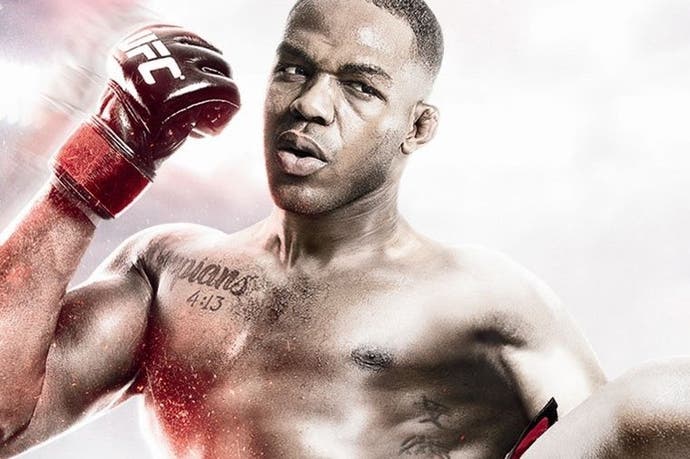EA Sports UFC demo performance analysis
Console warriors.
With the battle between PlayStation 4 and Xbox One heating up these past few weeks, it seems somewhat fitting that the next throwdown between these console giants should take place in the Octagon. EA Sports UFC makes its next-generation debut this month utilising the Ignite Engine, promising to deliver a new sense of realism, and its arrival brings to mind the impressive Fight Night Round 3, released a few months after the launch of the Xbox 360, and its incredible presentation. More than eight years later, one might wonder just how much of an evolution we might see, and with the release of the UFC demo this past week we got the opportunity to find out.
This limited demo includes just two fighters, Alexander Gustafsson and Jon Jones, throwing down in a single match, but it paints a fairly positive picture. Despite EA Sports focusing on 1080p60 with its suite of launch games, UFC appears instead to operate at 1600x900 on both consoles, making this the third PS4 title to forego a full 1080p presentation, but thankfully the darkened arenas, generous post-processing, and lack of finer distant detail prevent this from ruining the experience and we're still left with a clean presentation. It's only when examining selected anti-aliasing techniques that we see any real differences between the two.
The PS4 version utilises a much more comprehensive 4x MSAA solution (perhaps with a post-process anti-aliasing technique on top) that manages to nearly eliminate aliasing in most situations despite the lower resolution. Xbox One doesn't fare quite so well, with image quality falling short of the PS4 version - 2x MSAA appears to be present, though we're not sure if there's a post-process on top, or whether we're just seeing the results of upscaling.
"Despite EA Sports focusing on 1080p60 with its suite of launch games, UFC appears instead to operate at 1600x900 on both consoles."
That said, UFC makes a convincing argument for utilising 900p in select situations. In a wide open, well-lit stadium a lower resolution could really damage the presentation but it's clear that in situations like this, the lower rendering resolution doesn't greatly detract from the experience. Provided that anti-aliasing is up to snuff, it's still possible to achieve excellent image quality.
Surrounding the Octagon is a lovingly detailed, fan-filled arena with a fully 3D crowd, working jumbotrons, and bright spotlights. We've seen some of this before in last-generation games such as EA Sports' own MMA, but the level of detail and precision of the lighting effects really make a difference here and bring the arena to life. Looking closer within those eight walls, we see a smattering of highly detailed texture and shader work. Textures are detailed to the point that it's nearly impossible to fully appreciate the subtly of the fibres and materials during normal gameplay, but when the camera goes in for a close-up it's nice to see.
The real focus, of course, is the fighters and UFC doesn't disappoint here. Muscles and soft tissue bounce and move realistically, sweat pours over the skin, and limbs seem to demonstrate real weight and heft. Models also receive a very realistic skin shader, reacting naturally to the surrounding lighting. We also see clean, artefact-free soft-shadows cascading over everything, appearing just a tad sharper on PS4. There's also a nice collection of camera focus effects used to create an attractive depth-of-field effect, helping to highlight the two fighters. It all feels cohesive and refined.
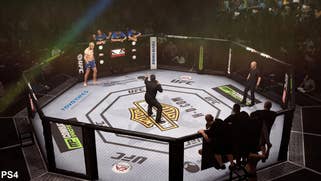



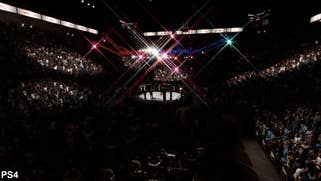

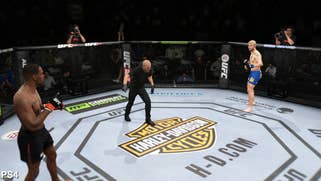

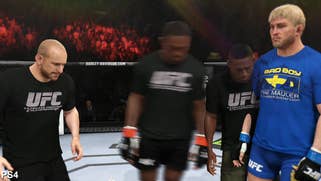
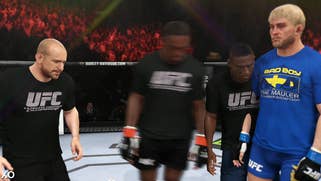
It's really the excellent implementation of per-object motion blur that steals the show here and manages to sell the action and accentuate animations. This also stands as the second noticeable difference between the two versions: motion blur on Xbox One operates at a lower precision, utilising half the samples of the PS4 game. This is most obvious during more exaggerated motions that reveal artefacts along object edges where the blur is applied. Comparatively, the effect is remarkably clean and mostly artefact-free on PS4. The potent mix of high-quality anti-aliasing and high-precision motion blur allows the PS4 version to shine in ways where Xbox One feels a tad lacking.
Unfortunately, despite utilising a lower resolution, EA hasn't aimed any higher when it comes to frame-rate, with a target of 30fps on both consoles. While they both generally maintain this level of performance, we found that slight frame-rate disturbances impact the fluidity of the experience, particularly on PS4. The fights themselves maintain a mostly consistent update, but the rest of the experience feels unpolished as a result. We also observe occasional torn frames manifesting on PS4 along the top ten per cent of the image though the darkened arena does a good job at hiding this flaw most of the time.
So, while PS4 has a distinct advantage in terms of image quality, it is the Xbox One version of the game that has the slightest of performance advantages. Once the fight begins, however, they both put up similar statistics and the PS4 issues - as small as they are - will hopefully be corrected for launch.
"While PS4 has a distinct advantage in terms of image quality, it is the Xbox One version of the game that has a small performance advantage."
Looking beyond the frame-rate, there are also issues with the interface surrounding the game. This aspect of UFC feels incredibly unpolished and poorly optimised with transitions often stuttering and skipping about while moving between menus. These types of issues regularly appear in EA Sports titles, and we feel that it's about time something is done about it. While not inherently key to delivering a great gameplay experience, these interface issues do add up over time and create something that feels less polished than we'd like. Along those same lines it should be noted that loading times on Xbox One are significantly longer than on PS4. You're looking at around 36 seconds to load a match on Xbox One while the PS4 is ready to go in just 20.
UFC is an interesting release as it's one of EA Sports' first attempts at dropping support for last-generation consoles in favour of the latest Sony and Microsoft systems. There's a noticeable increase in fidelity but the mild performance and polish issues do ultimately keep this demo from feeling just right. Does UFC represent a suitable eight-year leap over Fight Night Round 3? Right now, based on this demo code, we're inclined to say "no, but..." It's an attractive game, no doubt, but it feels like an evolution of the techniques first introduced in 2006. It's a solid progression though and a strong enough foundation to build upon in future titles.
Interestingly, UFC does manage to further support what ex-Nvidia, now-Epic developer Timothy Lottes discussed in a now-removed blog post from a few years back. The idea of focusing more on a softer, filmic image as opposed to a sharp pixel-perfect look that we've become so accustomed to has its merits. As we observed with games such as Ryse, sometimes the end results can push beyond the number of pixels on screen and create surprising results. However, the technique relies upon excellent anti-aliasing and in this respect, the demo code suggests that despite equal pixel-counts, the PS4 game has the visual edge.
